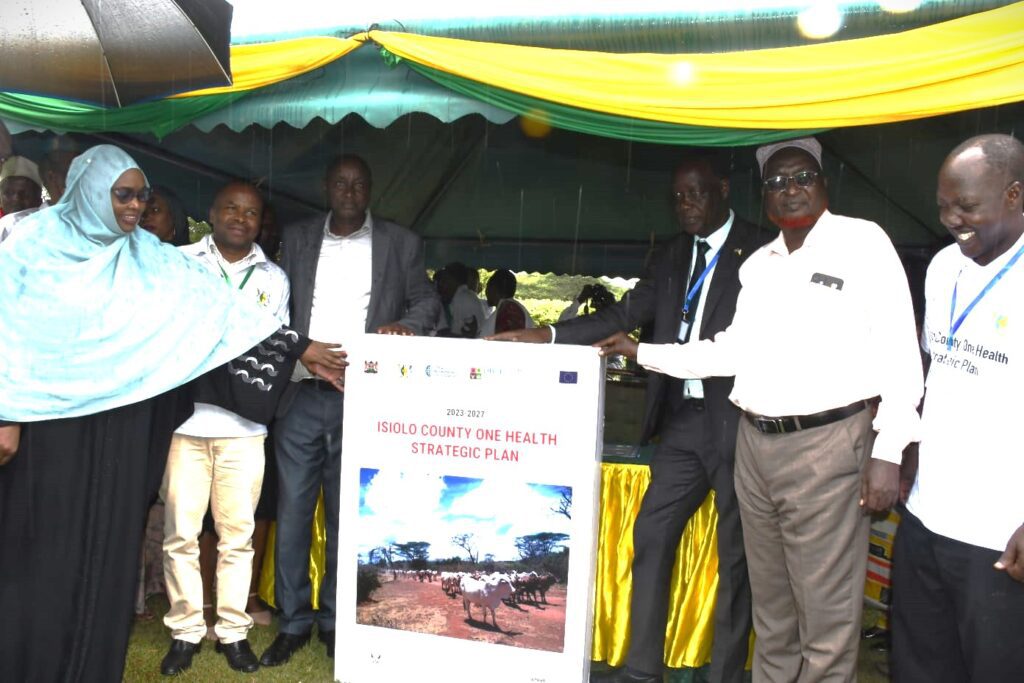KENYA – Isiolo County has made a significant advancement in addressing health challenges by launching its One Health Strategic Plan, becoming the second county in Kenya—after Turkana—to adopt this innovative approach. The One Health strategy integrates human, animal, and environmental health into a unified system tailored to Isiolo’s pastoralist communities’ unique needs. This initiative is part of a broader project spanning the Horn of Africa, implemented through a partnership with Amref Health Africa, Vétérinaires Sans Frontières-Swiss, and the International Livestock Research Institute (ILRI), with activities across Kenya, Ethiopia, and Somalia.
This integrated approach is especially crucial in addressing emerging infectious diseases, the impacts of climate change, and health risks tied to the pastoralist lifestyle. Isiolo has long battled zoonotic diseases; such as Rift Valley fever, brucellosis, and kala-azar; that pose significant threats to human and animal health, disrupting livelihoods in the process. Often compartmentalised by sector, traditional health systems have been ill-equipped to address these interconnected issues. The One Health model offers a timely, integrated solution to address the county’s complex health challenges, improving human and animal health while enhancing environmental sustainability.
Under the four-year One Health Strategy, developed for 2023-2027, Isiolo County’s Departments of Health; Agriculture, Livestock and Fisheries; and Environment and Climate Change Resilience signed an MoU committing to collaboration towards implementation of the strategy and enhancing primary healthcare and improving pandemic preparedness with a focus on three pillars.
The first pillar focuses on the co-creation of County One Health Units (COHUs), which foster collaboration across health, agriculture, environment, and livestock sectors. These units serve as collaborative hubs, enhancing coordination to tackle health challenges at their roots. Through COHUs, Isiolo has made significant strides in fostering partnerships, streamlining resource allocation, and developing policies that promote more effective health interventions. This integrated approach strengthens the county’s capacity to respond to emerging health risks while ensuring environmental sustainability and improved public health outcomes.
The second pillar emphasises enhancing surveillance and readiness to mitigate zoonotic and environmental health threats. The project has equipped 70 Community Health Promoters (CHPs) and local leaders with the capacity to report real-time data on hazards such as floods, droughts, and disease outbreaks. This system facilitates early detection of disease outbreaks, allowing quicker intervention and reducing the need for disruptive livestock quarantines. By integrating weather-monitoring tools, the strategy anticipates environmental conditions favourable to disease outbreaks, such as rainfall patterns linked to Rift Valley fever, and empowers herders to take preventive actions.

The CEC for Finance, Dr Lawrence Mwongela, speaking on behalf of the County Governor during the launch, commended the proactive approach of the One Health strategy, saying, “This strategy is crucial in mitigating the impact of diseases like Rift Valley fever, which has historically devastated livestock and strained our public health systems. In past outbreaks, livestock quarantines and movement restrictions led to significant economic losses for pastoralist families who depend on their herds for income and sustenance. With enhanced surveillance, Isiolo is better positioned to detect potential outbreaks early and implement localised containment measures, reducing the need for widespread restrictions. But we need to build the capacity of more community members to achieve 100% coverage.”
The third pillar underscores the importance of research. Collaborations with universities, research institutions, and local communities have yielded vital studies on zoonotic diseases, antimicrobial resistance, and the effects of climate change on public health. These insights will inform evidence-based health policies tailored to Isiolo’s unique needs.
Beyond immediate health benefits, the One Health strategy offers long-term improvements in food security and economic stability. It directly supports Isiolo’s pastoralist communities, whose livelihoods rely heavily on livestock. The strategy also helps secure the financial stability of families dependent on their herds for sustenance and income.
A recent study by the project indicates that the One Health approach yields a fivefold return on investment for every dollar spent on disease outbreak prevention, reduced healthcare costs, and ecosystem preservation.
The launch of Isiolo’s One Health strategy aligns with Amref Health Africa’s 2023-2030 vision, which aims to strengthen primary healthcare systems in underserved regions through inclusive and preventive solutions. Integrating efforts across multiple sectors, the One Health model creates a robust framework for enhancing pandemic preparedness and addressing Isiolo’s complex and interconnected health challenges.
Looking ahead, the One Health strategy demonstrates the power of cross-sector collaboration in building resilience, improving food security, and creating sustainable health systems. Isiolo’s adoption of this integrated approach paves the way for similar initiatives across the Horn of Africa, leading to healthier, more resilient communities.
The launch event was made possible by the Building Resilience Against Climate Effects (BRACE) project.
Edna Mosiara – Communications Officer, Amref Health Africa in Kenya
